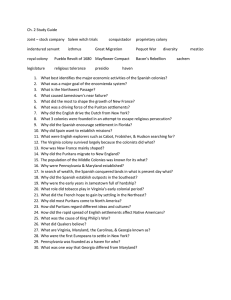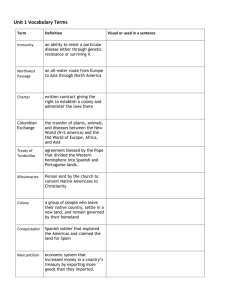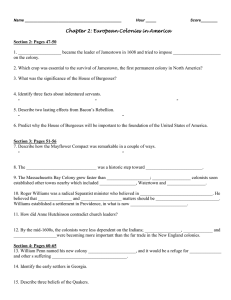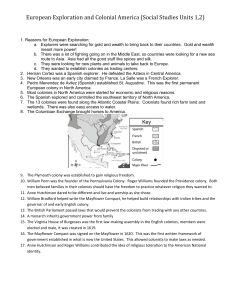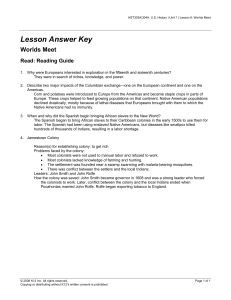Uploaded by
Timneshia Harris
Age of Discovery Journal: European Exploration & Colonization
advertisement
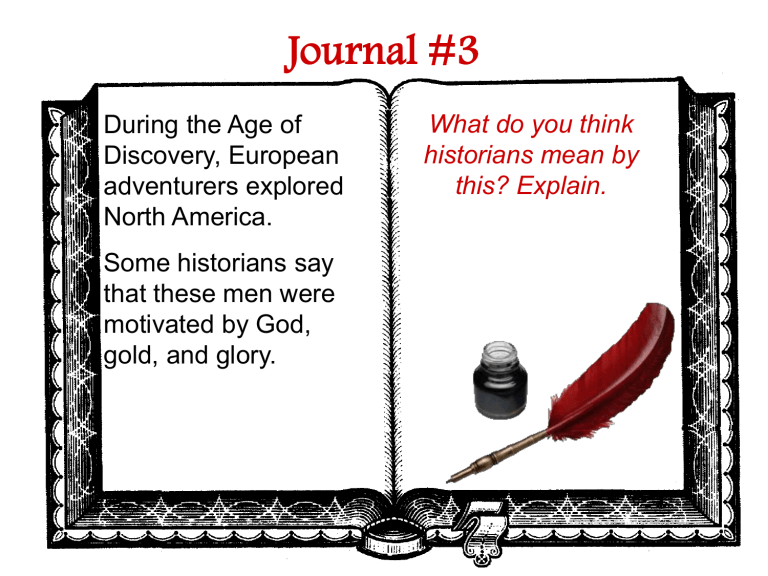
Journal #3 During the Age of Discovery, European adventurers explored North America. Some historians say that these men were motivated by God, gold, and glory. What do you think historians mean by this? Explain. Iroquois Prince Henry Taino Treaty of Tordesillas Columbian Exchange What legacy did the Spanish have on the Americas? Spanish explorers were lured to the New World by the prospect of a vast land filled with gold and silver. These explorers became known as conquistadors (conquerors) that targeted Central & South America. ~ Historical Meeting ~ Hernando Cortez and Montezuma Montezuma shared the Aztecs gold supply with Cortez, but the Aztec people eventually rebelled and drove the Spanish out and killed Montezuma (seen as a traitor). The Aztecs were able to repel the Spanish, but they could not stop the disease. The Spanish launched a counter attack, but the Aztec force was greatly reduced by small pox and measles. The Aztec surrendered and the Spanish burned Tenochtitlan (becomes modern day Mexico City) to the ground and then Cortez laid out plans for the Spanish colony of New Spain. Spanish settlers in the Americas were known as peninsulares. Marriage between peninsulares and native women was common. These marriages created a large mestizo population. The Spanish still continued to oppress natives by instituting a policy called enomienda. Encomienda - Natives farmed, ranched, or mined for the Spanish landlords, who had received the rights to their labor. The Spanish monarchy tried to encouraged fair treatment of the natives, so they abolished encomienda. To meet their labor needs, the Spanish turned to African slaves. Ponce de Leon - Florida Explored Florida and the surrounding areas for gold and possibly a Fountain of Youth, but were constantly battling local natives, disease and starvation. In 1562, discouraged by the lack of economic success, Spain abandoned further exploration. Francisco Vasquez de Coronado - Southwest Led the first expedition into what is now Arizona, New Mexico, Texas, Oklahoma, and Kansas to look for another wealthy empire to conquer. After wandering for two years, he did not find a large wealthy empire or any precious metals. Spanish priests and soldiers began forcing Native Americans to help support missions by paying a tribute. Native Americans who practiced their native religion or refused to pay the tribute were beaten. Spain will slowly lost its dominance in the Americas because: 1. Continued rebellions that were well organized by Native American leaders. 2. Defeat of the Spanish Armada by the British. What legacy did the Spanish have on the Americas? Were the early English colonies in North America successful? One of England’s first attempt at a colony in the “new world” was at Roanoke Island. John White sailed back to England for supplies the colony. Upon this return to Roanoke, he found the settlement empty and the colonists had vanished. All that was found was the word “CROATOAN” (a Native American tribe) was carved into a tree. In 1607, the English created a new settlement in Virginia, called Jamestown. John Smith was the leader of the settlement, which struggled early on (112 out of the 150 colonists died within the first 8 months). John Smith was able to get the Powhatan people to provide for the upcoming winter season. Soon after though, violence erupted between colonists and natives. In Jamestown, colonist John Rolfe developed a new type of high-quality tobacco. Colonists were exporting more than 1.5 million pounds every year, but something was missing… Indentured Headright Servants System - Policy A person of granting who has 50 contracted acres of land to work to each for another settler and for atolimited each period, family member often in return who for accompanied travel expenses, him. food and shelter. The leaders of Jamestown demanded tributes of corn and labor from the Powhatan. Soldiers “encouraged” the Powhatan to give in to their demands by setting their villages on fire and stealing their children (one of which was Pocahontas) from them. Continued conflicts between the colonists and natives, led James I to make Virginia a royal colony. James sent reinforcements to Virginia strengthen Virginia and conquered the Powhatan. Virginia frontiersman were being attacked by N.A.s and they asked for help from the governor of Virginia, but received “NO” for an answer. Nathaniel Bacon would not take “NO” for an answer, so he raised his own army and attacked not only the N.A.s, but also marched on Jamestown to confront colonial leadership. Bacon’s complaints were: 1. Need an army to defend against the N.A.s 2. Lack of representation in the House of Burgesses 3. Being taxed and governed without their consent. Bacon’s men ended up setting fire to the town and the colonial leadership fled. Luckily for the colonial leaders, Nathaniel Bacon died a month after the siege of Jamestown and colonial leaders were able to restore order. Stick a fork in him…he is DONE! Were the early English colonies in North America successful? What impact did the Puritans have on the New England colonies? Puritans were members of the Anglican Church in England, who wanted the church to purify itself and remove all traces of the Catholic Church. Dear Lord, Some Puritans thought Thanks for football the best thing to do was on Sundays!! to break away from the Anglican Church, so they became known as Separatists, known today as Pilgrims. The Separatists needed to escape persecution, so many fled to Holland, but eventually in 1620 the Pilgrims left for America and founded Plymouth Colony. MAYFLOWER COMPACT An agreement reached by the Pilgrims on the Mayflower (their ship) just before they landed at Plymouth Rock. This document bound them to live in a civil society according to their own laws. Historical Significance: It remained the fundamental law of the colony and became a landmark of American democratic government. John Winthrop was the first governor of the Massachusetts Bay Colony. The port town of Boston became their capital. Within the first year 1,000 men, women, and children (both Puritan and nonPuritan) came. The colony grew so Historical Significance: As the colony large that it eventually developed, a close relationship incorporated Plymouth between Church and State developed. Colony into it. Roger He was a colonist in the Massachusetts Bay Colony, Williams but was dissatisfied with how things were going. Williams believed that the government officials had no business in punishing settlers for their religious beliefs. He was ordered to be arrested, but he fled south to set up a new colony, which he called Providence. Historical Significance: Anne Williams guaranteed separation of Hutchinson church and state and religious freedom. She was banished from the colony as well because she preached that worshippers did not need the church or ministers to interpret the bible for them. PEQUOT WAR Disputes over land between the colonists and the N.A.s finally reached a breaking point. The Pequot nation took a stand against the colonists. 90 English colonists and hundreds of their N.A. allies surrounded a Pequot fort. The English shot all but a few of the 500-600 people in the fort (men, women, and children). KING PHILIP’S WAR Chief of the Metacom, whom the English referred to as King Philip organized an alliance between his tribe and several others to stand up to the colonists. The N.A.s used hit and run tactics against outlying settlements. For two years the two sides waged mutual brutality and destruction. The N.A.s gradually surrendered or fled to the west. To commemorate their victory, the Puritans exhibited Metacom’s head for 20 years. What impact did the Puritans have on the New England colonies? How did the Middle and Southern colonies develop? The Dutch called their colony New Netherlands and its major port and capital became New Amsterdam. The Dutch had less problems with the Native Americans (Iroquois) because they were less interested in conquering them, and more interested in trading with them. The English felt that the Dutch colony was a “wedge” between their New England colonies and their Southern colonies. The king of England granted his brother James, the Duke of York to sail a fleet to New Amsterdam and drive out the Dutch. When the English arrived, the unpopular governor of the colony, Peter Stuyvesant, tried to rally the Dutch to defend the settlement. The Dutch surrendered without a shot fired. James renamed the colony: New Netherlands = New York New Amsterdam = New York City 2 Friends received Territory = New Jersey William Penn and the Quakers believed they could no longer practice their religion in England because of religious persecution. Major beliefs: + Quakers held services without ministers. + Anyone could speak at services. + Dressed Plainly. + Embraced Pacifism – (Opposed war & Military Service) Penn saw his colony as a “holy experiment” in living. He gave 50 acres of land, the right to vote, religious freedom to every male that came. Penn made sure his colonists worked with the Native Americans, therefore the colony had no major problems with them. Historical Significance: The principles of equality, cooperation and religious tolerance on which he founded his vision would eventually become fundamental values of the new American nation. MARYLAND King Charles I granted George Calvert the region known as Maryland today. The colony of ended up becoming famous for its religious toleration (Catholics). CAROLINAS King Charles II awarded a group of key supporters the land between Virginia and Spanish Florida that soon become known as North & South Carolina. GEORGIA James Oglethorpe created a colony as a haven for those imprisoned for debt. Oglethorpe’s policies in Georgia prohibited slavery and the drinking of rum which did not encourage immigrants to come to his colony. The King takes over the colony and overturns the policies. How did the Middle and Southern colonies develop?
